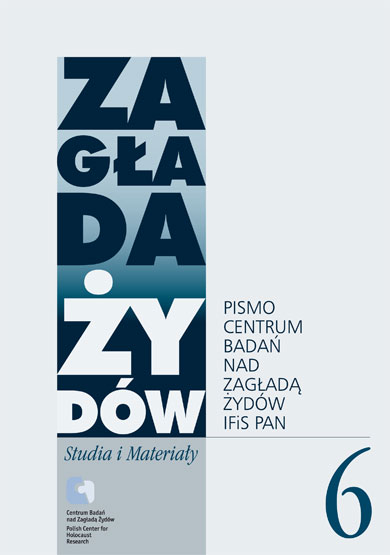„Wszystkich zabrali. Zostałam Samajedna. Bez nikogo”. Dziennik intymny Fryderyki Brück ze Stanisławowa
Zagłada Żydów. Studia i Materiały, Nr 6 (2010), Strony: 256-270
Data zgłoszenia: 2020-12-06Data publikacji: 2010-12-30
 https://doi.org/10.32927/zzsim.726
https://doi.org/10.32927/zzsim.726
Abstrakt
The article is an introduction to Fryderyka Brück’s diary covering notes from 7 May 1941 to 1 August 1942. The author of the diary came from a highly Polonized, welloff Jewish family living in Stanisławów. Her diary begins when she is only a carefree 19-year-old student with a peaceful life. The situation changes drastically after Germans have occupied the town. Fryderyka describes the first Nazi action conducted on Jews and Poles in Stanisławów when together with other representatives of the intelligentsia her father was arrested. One of the most tragic events reported in the diary is a bloody massacre of Jews in the cemetery when 10,000 Jews were killed on 12 October 1941. The notes cover the times of the move to the ghetto and life in the closed district. The girl describes the moment when on 31 March 1942 the whole of Brück family, except for Fryderyka, was taken and transported to the camp. At that
time, there is the longest gap in notes and later – the last hastily and carelessly written entry reporting chaotic events from four months. The main subject of the diary is not historical events but the relationship with Misiek Bachar. Therefore, the diary has the character of intimate notes, not intended to be read by third party. The narrative line is the emotional life, the author’s love adventures and sexual experiences. She always presents the events from the perspective of personal experience. Therefore, it might be said that it is an ordinary diary of an “average” teenager but this is what its power of message consists in nowadays. The intimacy and the specific naivety of the diary intertwines with the terror of historical events, not necessarily made conscious but also undoubtedly repressed cruelty of the Holocaust which will ultimately interrupt the author’s confessions.
Słowa kluczowe
dziennik intymny , kobiety i Zagłada , Stanisławów , getto
Licencja
Prawa autorskie (c) 2010 Autor & "Zagłada Żydów. Studia i Materiały"

Utwór dostępny jest na licencji Creative Commons Uznanie autorstwa 4.0 Międzynarodowe.
https://creativecommons.org/licenses/by/4.0
Podobne artykuły
- Klaus Peter Friedrich, Isaiah Trunk, Łódź Ghetto: A History; Andrea Löw, Juden im Getto Litzmannstadt. Lebensbedingungen, Selbstwahrnehmung, Verhalten , Zagłada Żydów. Studia i Materiały: Nr 3 (2007)
- Redakcja Czasopisma, Nagroda im. Israela Gutmana dla Karoliny Panz , Zagłada Żydów. Studia i Materiały: Nr 12 (2016)
- Roni Stauber, Filip Friedman i początki badań nad Zagładą , Zagłada Żydów. Studia i Materiały: Nr 11 (2015)
- Przemysław Czapliński, Zagłada jako horror. Kilka uwag o literaturze polskiej 1985–2015 , Zagłada Żydów. Studia i Materiały: Nr 12 (2016)
- Alina Skibinska, „Przygody niebezpieczne i męczarnie”. Relacje dwóch kobiet o tym, jak przeżyły Zagładę na terenie powiatu biłgorajskiego w dystrykcie lubelskim , Zagłada Żydów. Studia i Materiały: Nr 20 (2024)
- Rachel Feldhay Brenner, Głosy z czasu Zagłady. Dwie relacje świadków z getta w Stanisławowie , Zagłada Żydów. Studia i Materiały: Nr 3 (2007)
- Adam Puławski, „Benzyny zużyto 8 litrów”. Prozaizacja Zagłady na przykładzie dokumentacji Archiwum Państwowego w Lublinie Oddział w Chełmie , Zagłada Żydów. Studia i Materiały: Nr 14 (2018)
- Dariusz Libionka, Jan Grabowski, Anatomia donosu ks. Stanisława Trzeciaka na ks. Tadeusza Pudra , Zagłada Żydów. Studia i Materiały: Nr 13 (2017)
- Agnieszka Haska, Międzynarodowa konferencja naukowa „Być świadkiem Zagłady”(Warszawa, 22–23 kwietnia 2013 r.) , Zagłada Żydów. Studia i Materiały: Nr 9 (2013)
- Ewa Wiatr, Kawalerowie Krzyża Żelaznego w getcie łódzkim , Zagłada Żydów. Studia i Materiały: Nr 8 (2012)
<< < 1 2 3 4 5 6 7 8 9 10 11 12 13 14 15 16 17 18 19 20 21 22 23 24 25 26 27 28 29 30 31 32 33 34 35 36 > >>
Możesz również Rozpocznij zaawansowane wyszukiwanie podobieństw dla tego artykułu.
 English
English
 Język Polski
Język Polski








